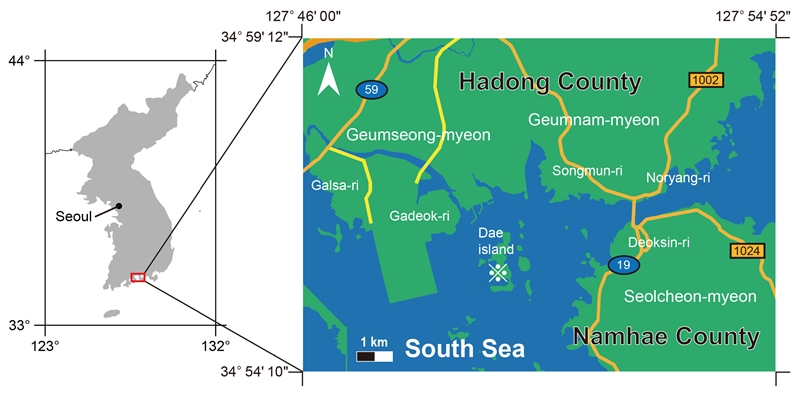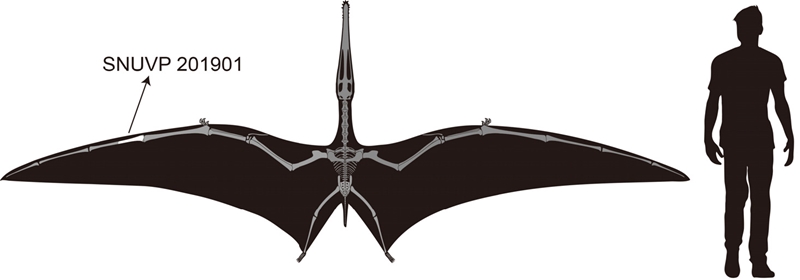
경상남도 하동군 하부 백악기 하산동층에서 산출된 익룡 지골 화석
초록
경상남도 하동군 금남면 대도의 해안선에 노출된 중부 하산동층(Aptian)에서 익룡의 네 번째 앞발가락 뼈 일부가 발견됐다. 전기 백악기에 생존했던 아시아 익룡들과의 크기 및 형태 비교를 통해 이 화석을 cf. Boreopteridae로 분류했다. 추정된 발 크기는 같은 층에서 보고된 생흔종 Pteraichnus koreanensis의 것보다 훨씬 크며, 앞뒤 발자국 크기가 서로 비슷한 P. koreanensis와 달리 Boreopteridae의 앞뒤 발자국 크기는 서로 다르기 때문에 하산동층 시기에 최소한 두 종류의 익룡이 공존했음을 보여준다. 이전에 보고된 Boreopteridae는 모두 중국의 하부 백악기 이시안층(Aptian)에서 산출되었기 때문에 이 화석은 중국 밖에서 처음 보고되는 Boreopteridae에 대한 기록임과 동시에 이들의 분포가 남동쪽으로 크게 연장돼있었음을 보여준다. 또한 이 화석은 하성 퇴적층에서 발견됐기 때문에 Boreopteridae가 강 주변에서도 생활했음을 보여준다.
Abstract
A partial second wing phalanx of a pterosaur was discovered from the coastal outcrop of Dae Island (Hasandong Formation, Aptian), Geumnam-myeon, Hadong-gun, Gyeongsangnam-do, South Korea. It is assigned to cf. Boreopteridae based on the comparisons to other Early Cretaceous Asian pterosaurs in shape and size. The estimated manus and pes size of this specimen is heteropodous and much larger than those of the pterosaur ichnotaxon Pteraichnus koreanensis, which was known from the same formation, suggesting there were at least two groups of pterosaurs co-existed during the Hasandong time. Since boreopterids have only been reported from the Lower Cretaceous Yixian Formation (Aptian) of China, this new specimen not only represents the first record of boreopterids outside of the Yixian Formation but their distribution was also greatly extended to the southeast. Moreover, the occurrence in the fluvial deposits suggests that boreopterids also lived in the riparian environment as well as lacustrine one.
Keywords:
Boreopteridae, pterosauria, Hasandong Formation, Aptian, Hadong-gun키워드:
Boreopteridae, 익룡, 하산동층, Aptian, 하동군1. 서 론
익룡(Pterosauria)은 중생대 때 생존했던 비행이 가능한 파충류 무리다(Sues, 2019). 우리나라의 백악기 육성퇴적층에서는 지금까지 다양한 익룡 화석이 보고됐지만 대부분 생흔화석이다(Huh et al., 1996; Lockley et al., 1997; Seo, 1997; Hwang et al., 2002; Kim et al., 2006, 2012, 2019; Lee et al., 2008; Ha et al., 2018). 익룡은 비행을 위해 뼈가 얇았기 때문에 비행 동물의 특성상 화석화될 확률이 낮다. 이런 이유로 우리나라에서 보고된 익룡 체화석은 흔적화석보다 매우 적다. 지금까지 보고된 체화석은 낱개로 산출된 이빨 5개(Yun and Yang, 2001b; Yun et al., 2007)와 불완전하게 보존된 지골 1개 뿐이다(Lim et al., 2002a).
2002년 8월, 교신저자는 경상남도 하동군 금남면 대도의 남쪽 해안에 노출된 하산동층에서 익룡의 체화석 일부를 발견하고 수집했다(그림 1). 이 화석을 크기와 형태, 피질골(cortical bone)의 두께를 토대로 익룡의 뼈로 동정했다. 익룡의 뼈는 비행을 위해 피질골이 매우 얇기 때문에 수각류(Theropoda)의 상대적으로 얇은 뼈인 척골(ulna)과 요골(radius), 그리고 중수골(metacarpal)보다 훨씬 얇다(Currey and Alexander, 1985; Ricqlès et al., 2000; Chinsamy-Turan, 2005; Farke and Wilridge, 2013). 전기 백악기에 존재했던 조류(Aves) 역시 익룡처럼 매우 얇은 뼈를 갖고 있지만, 이 당시 조류의 지골 크기는 매우 작기 때문에 조류의 뼈는 아닌 것으로 판단된다(Benton, 2014; Sues, 2019). 게다가 관절구(condyle)가 조금 확장됐고 끝부분의 가장자리가 수직이라는 점, 그리고 골간(shaft)이 똑바르고 단면이 삼각형이나 원형이 아닌 타원형이라는 점은 이 화석이 익룡의 사지를 이루는 뼈 중 네 번째 앞발가락의 두 번째 마디를 이루는 지골임을 시사한다(Kellner and Tomida, 2000; Bennett, 2001; Witton, 2013). 현재 이 표본은 서울대학교 지구환경과학부 고생물학연구실에 보관돼있다(표본번호: SNUVP 201901; Seoul National University, Vertebrate Paleontology). 본 단보의 목적은 이 새로운 화석의 기재와 분류를 통해 우리나라 익룡에 대한 새로운 자료를 제공하는 데 있다.
2. 지질 개요
경상누층군의 신동층군에 속하는 하산동층은 정합적으로 하부의 낙동층과 상부의 진주층 사이에 존재한다(Chang, 1975; Choi, 1985). 하산동층의 두께는 약 1,200 m이며, 주로 사암, 역암, 그리고 실트암과 같은 하성 퇴적층으로 이루어졌다(Lee, 2007; Lee et al., 2008). 산출되는 실트암은 적색, 회록색, 그리고 농회색을 띠며, 특히 적색층에서는 석회질 단괴가 관찰된다(Choi, 1986). 하산동층이 형성될 당시에는 건기와 우기가 교차해 지속적인 하성 퇴적작용이 일어나지 않았다(Paik and Lee, 1998; Paik et al., 2001).
하산동층의 형성 시기는 초창기 연체동물 화석에 의해 Aptian에서 Albian으로 해석됐다(Yang, 1982). 고지자기 연구는 하산동층을 포함한 신동층군의 형성 시기를 Aptian 이후로 해석했으며(Doh et al., 1994), 지르콘 연대는 신동층군을 Aptian 후기에서 Albian의 후기 사이의 시대를 지시했다(Lee et al., 2010). 최근에는 하산동층의 형성 시기를 Aptian의 후반부로 보는데(Kang and Paik, 2013; Lee et al., 2018), 그 이유는 정합으로 피복하고 있는 진주층의 최대 퇴적 시기를 112.4±1.3 Ma로 보고 있기 때문이다(Lee et al., 2010).
하산동층은 우리나라 중생대층에서 척추동물 화석이 가장 다양하게 발견되는 지층이다(Choi and Lee, 2017). 산출된 척추동물 화석으로는 물고기(Lee et al., 2001; Yabumoto et al., 2006), 거북(Lee and Tomida, 2004), 악어(Lee and Lee, 2005; Yun et al., 2007), 익룡(Yun and Yang, 2001b; Lim et al., 2002a; Yun et al., 2007), 그리고 다양한 공룡(Paik et al., 1998a, 1998b; Paik, 2000; Park et al., 2000; Dong et al., 2001; Lee et al., 2001; Lim et al., 2002b; Lee, 2007; 2008; Lee and Lee, 2007; Yun et al., 2007; Park, 2016)이 있다. 식물(Kim et al., 2016)과 연체동물(Yang, 1982; Lee et al., 1990; Yun and Yang, 2001a)의 화석도 발견됐으며, 무척추동물(Kim and Paik, 1997; Kim et al., 2002)과 공룡알을 포함한 척추동물의 생흔화석(Yun and Yang, 1997; Lee, Y.-N. et al., 2001, 2008; Huh et al., 2003; Paik et al., 2015; Lee, H.-J. et al., 2018)도 흔히 발견된다.
3. 기 재
SNUVP 201901은 왼쪽 네 번째 앞 발가락의 두 번째 마디를 이루는 지골이다(그림 2). 표본은 얇고 길쭉한 형태를 띤다. 원위(distal) 부분은 훼손됐으며, 위아래로 납작한 골간과 근위(proximal)의 관절구가 보존됐다. 뼈 표면의 일부는 풍화됐으며, 근위부 관절구의 전면(anterior)과 후면(posterior)의 끝부분도 훼손됐다.
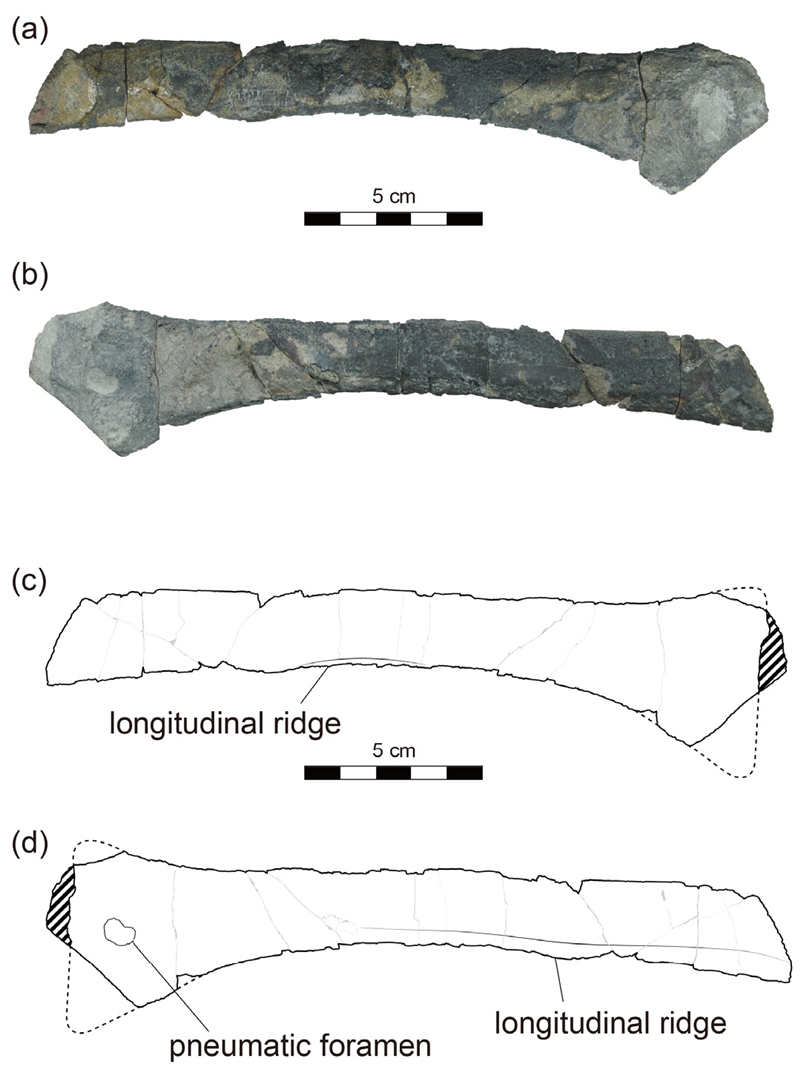
Second wing phalanx of cf. Boreopteridae (SNUVP 201901) from the Hasandong Formation. (a) in dorsal view (photo); (b) in ventral view (photo); (c) in dorsal view (line drawing); (d) in ventral view (line drawing). Dashed lines represents reconstructed areas. Diagonal solid lines indicate unremoved matrix.
대부분의 익룡과 마찬가지로 지골의 골간은 곧게 발달했다(O’Sullivan and Martill, 2018). 보존된 뼈의 길이는 197.97 mm이고 골간의 단면은 타원형이다(그림 3). 표본의 전면에서 후면 방향으로의 폭은 최소 19.61 mm, 최대 22.53 mm다. 폭은 원위로 향할수록 넓어진다. 배복(dorsoventral) 방향의 표본 높이는 최소 11.62 mm, 최대 11.72 mm다. 따라서 전면에서 후면 방향의 폭이 배복 방향의 높이의 두 배 정도 된다. 표본의 피질골은 후면과 배면(dorsal) 쪽이 전면과 복면(ventral) 쪽보다 얇다. 피질골의 두께는 전면이 0.84 mm, 후면이 최소 0.52 mm, 배면이 0.86 mm, 그리고 복면이 1.07 mm다. 몸체의 후면으로는 약하게 돌출된 종단돌기(longitudinal ridge)가 존재한다(그림 2). 이 구조는 원위로 향할수록 커지는 경향을 보인다. 종단돌기는 날개를 이루는 비막(patagium)이 붙는 부위로 추정되고 있다(Bennett, 2001; Hone et al., 2015).
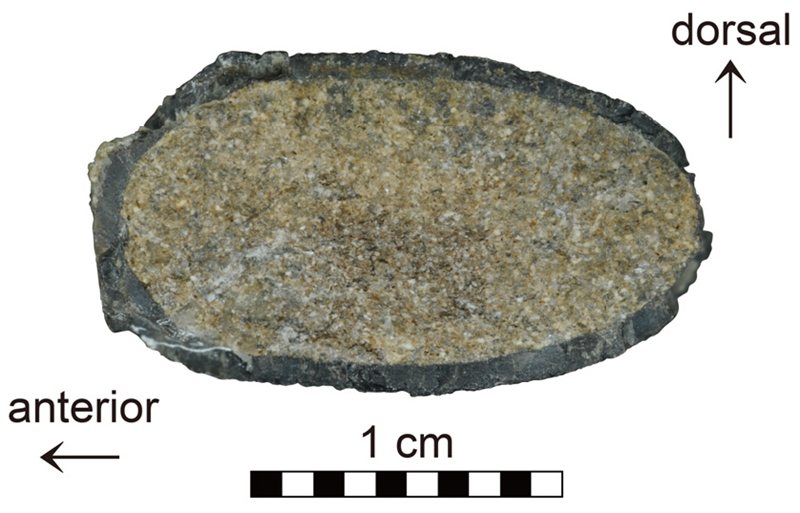
A cross-section of the second wing phalanx shaft of cf. Boreopteridae (SNUVP 201901) from the Hasandong Formation.
근위의 관절구와 가까운 전면의 가장자리는 살짝 S자로 휘어진다. 근위의 관절구는 전면과 후면을 향해 넓게 확장된 형태를 띤다. 보존된 관절구의 전면에서 후면 방향의 최대 폭은 40.14 mm다. 관절구의 전면 가장자리는 근위를 향해 전면으로 상대적으로 적게 휘어진다. 반면 후면 가장자리는 비교적 급격하게 근위 방향으로 휘어져 잘 발달된 후면돌기(posterior process)를 형성한다. 거의 수직으로 발달한 관절구의 근위부 가장자리가 배면과 복면에서 관찰 가능하다. 하트모양의 함기공(pneumatic foramen) 한 개가 관절구의 복면 표면에 존재한다. 관절구의 단면은 삼각형이다.
지골의 형태가 똑바르다는 점에서 SNUVP 201901은 전면으로 휘어진 Rhamphorhynchidae나 Dsungaripteroidea의 것과 다르다(Unwin, 2003; Padian, 2008). 뼈의 단면이 타원형인 점은 대부분의 Pterodactyloidea에서 볼 수 있는 특징이다(Bennett, 2001). 반면 Rhamphorhynchinae의 것은 단면이 C형이고(Padian and Rayner, 1993; Unwin, 2003), Azhdarchidae는 T형 혹은 Y형이다(Martill and Frey, 1999). Pteranodontidae에 속하는 Pteranodon은 예외적으로 원형인 지골 단면을 갖고 있다(Bennett, 2001). SNUVP 201901의 뼈 단면의 폭과 높이의 비율은 2:1로 Dsungaripterus와 비슷하지만(Young, 1964), 피질골의 두께에서 차이를 보인다. SNUVP 201901의 경우, 피질골이 단면의 폭과 높이의 7~16%를 차지하지만 Dsungaripteridae는 피질골이 약 55%를 차지한다(Unwin et al., 1996; Unwin, 2003). SNUVP 201901의 종단돌기가 원위로 갈수록 그 크기가 커지는 것은 Pteranodon의 경우와 유사하다(Bennett, 2001). 반대로 Dsungaripterus의 것은 원위로 향할수록 크기가 줄어든다(Young, 1964).
Aptian에 아시아에서 생존했던 익룡 중에서 SNUVP 201901의 것과 가장 유사한 관절구를 가진 분류군은 Boreopteridae와 Dsungaripterus (Dsungaripteridae)이다(Young, 1964; Lü and Ji, 2005; Lü, 2010)(그림 4). 하지만 앞서 언급했듯이 Dsungaripteridae는 피질골이 두껍기 때문에 피질골이 얇은 SNUVP 201901과 구별된다(Unwin et al., 1996; Unwin, 2003). 또한 종단돌기가 원위로 향할수록 크기가 커지는 점도 Dsungaripterus의 것과 반대다(Young, 1964). 더 나아가, SNUVP 201901은 Dsungaripterus의 네 번째 앞 발가락의 두 번째 지골보다 훨씬 크기가 크다. 화석의 크기는 오히려 중국의 이시안층(Yixian Formation, Aptian)에서 산출된 Boreopteridae에 속하는 Zhenyuanopterus (그림 4d)의 것과 가장 유사하다(Lü, 2010). 하지만 배면에서 바라봤을 때 Zhenyuanopterus의 관절구의 후면 가장자리는 SNUVP 201901의 것보다 상대적으로 덜 휘어져 있다. 이런 형태적 다름은 분류군의 차이거나, 혹은 같은 분류군 내에서의 개체변이에 따른 결과일 수도 있다. 그러나 본 표본의 불완전성 때문에 이것을 새로운 분류군으로 구분하기에는 무리가 있다. 따라서 SNUVP 201901을 cf. Boreopteridae로 분류한다.
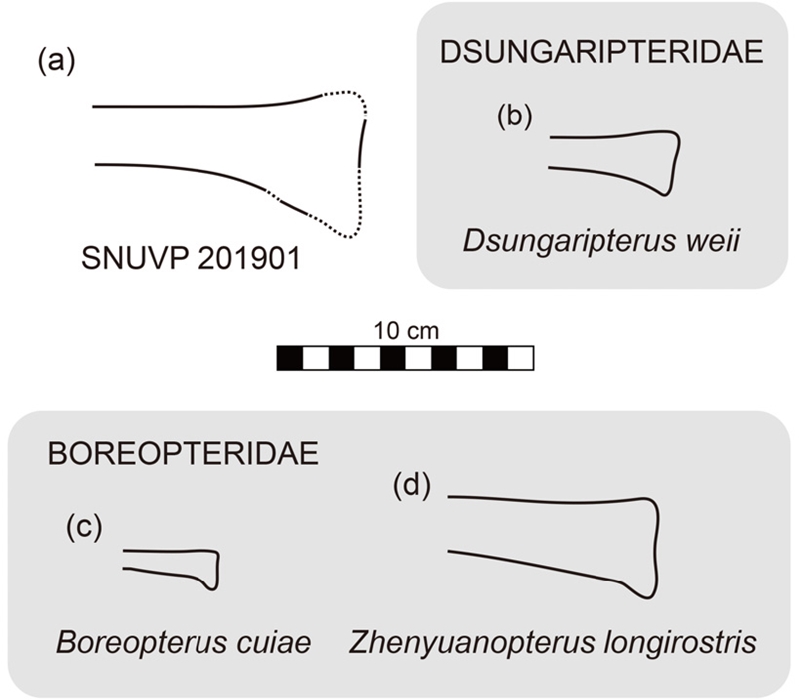
Comparison of proximal condyles of second wing phalanxes in selected Asian pterosaurs from Aptian. (a) cf. Boreopteridae (SNUVP 201901) from the Hasandong Formation, (b) Dsungaripterus weii (after Young, 1964), (c) Boreopterus cuiae (after Lü and Ji, 2005), and (d) Zhenyuanopterus longirostris (after Lü, 2010).
4. 토 의
Boreopteridae의 것으로 추정되는 이빨 화석들이 이미 하산동층에서 보고된 적이 있다(Yun et al., 2007; Choi and Lee, 2017). 하지만 이 이빨들은 모두 분리된 채 발견되었기 때문에 SNUVP 201901과 같은 분류군에 해당되는지는 불확실하다. SNUVP 201901과 가장 비슷한 Zhenyuanopterus의 지골 길이는 약 270 mm이며 (Lü, 2010), 이와 비교했을 때 SNUVP 201901의 전체 길이는 337.3 mm로 추정된다. 더 나아가, Zhenyuanopterus의 날개 너비는 350 cm이므로(Lü, 2010; Witton, 2013), 이를 통해 SNUVP 201901의 날개 너비를 복원하면 약 431 cm가 된다. 따라서 SNUVP 201901가 Zhenyuanopterus보다 더 큰 Boreopteridae 개체일 가능성이 있다.
위와 같은 방법으로 SNUVP 201901의 앞발과 뒷발의 길이도 추정했다. 앞발과 뒷발의 길이는 각각 약 90 mm, 약 70 mm다. 이 수치는 하산동층에서 보고된 생흔종인 Pteraichnus koreanensis의 크기(앞발 길이 25.6 mm, 뒷발 길이 25.7 mm)보다 훨씬 크다(Lee et al., 2008). P. koreanensis를 어린 Boreopteridae 개체의 흔적이라고 추정해볼 수도 있지만 Boreopteridae에 속하는 익룡들은 앞발이 뒷발보다 크다(Lü and Ji, 2005; Lü, 2010). 따라서 앞발과 뒷발 크기가 서로 거의 같은 P. koreanensis를 Boreopteridae의 흔적이라 보기 어렵다. 결국 하산동층이 형성될 당시에 적어도 두 무리의 익룡이 서식했었다고 추론해볼 수 있다.
Boreopteridae에는 Boreopterus cuiae (Lü and Ji, 2005), Boreopterus giganticus (Jiang et al., 2014), 그리고 Zhenyuanopterus longirostris (Lü, 2010), 총 3종이 존재하며 모두 중국의 이시안층에서 보고됐다. 따라서 SNUVP 201901은 이들의 분포지역을 벗어나 처음으로 보고되는 Boreopteridae에 대한 확실한기록임과 동시에 이들의 서식지가 보다 남동쪽으로 크게 확장돼 있었음을 보여주는 증거다. 이시안층의 Boreopteridae는 모두 호성 퇴적층에서 산출됐기 때문에 이들이 호수 일대에서 살았을 것으로 추정됐지만(Zhou, 2004), 하성 퇴적층에서 산출된 SNUVP 201901은 Boreopteridae가 호수뿐만 아니라 강 주변에도 생활했음을 보여준다.
Acknowledgments
본 단보을 개선하도록 도움을 주신 익명의 심사위원님, 편집위원님, 그리고 편집위원장님께 감사드립니다. 본 연구는 교신저자에게 지원된 2019 한국연구재단 이공분야기초연구사업(중견연구자지원사업, 2019R1A2B5B02070240) 연구비로 수행됐습니다.
References
- Bennett, S.C., 2001, The Osteology and Functional Morphology of the Late Cretaceous Pterosaur Pteranodon Part I. General Description of Osteology. Palaeontographica Abteilung A Band 260 Lieferung, 1-6, 1-112.
- Benton, M.J., 2014, Vertebrate Palaeontology, (4th ed.). Wiley Blackwell, Chichester, 468 p.
- Chang, K.H., 1975, Cretaceous stratigraphy of southeast Korea. Journal of the Geological Society of Korea, 11, 1-23.
- Chinsamy-Turan, A., 2005, The microstructure of dinosaur bone: deciphering biology and fine-scale techniques. Johns Hopkins University Press, Maryland, 195 p.
- Choi, H.-I., 1985, Sedimentology and its implications for stratigraphic classifications of the Cretaceous Gyeongsang Basin. Journal of the Geological Society of Korea, 21, 26-37.
-
Choi, H.I., 1986, Fluvial plain/lacustrine facies transition in the Cretaceous Sindong Group, south coast of Korea. Sedimentary Geology, 48, 295-320.
[https://doi.org/10.1016/0037-0738(86)90034-5]

-
Choi, S. and Lee, Y.-N., 2017, A review of vertebrate body fossils from the Korean Peninsula and perspectives. Geosciences Journal, 21, 867-889.
[https://doi.org/10.1007/s12303-017-0040-6]

-
Currey, J.D. and Alexander, M., 1985, The thickness of the walls of tubular bones. Journal of Zoology (London), 206, 453-468.
[https://doi.org/10.1111/j.1469-7998.1985.tb03551.x]

- Doh, S.-J., Hwang, C.-S. and Kim, K.-H., 1994, A paleomagnetic study of sedimentary rocks from Kyeongsang Supergroup in Milyang sub-basin. Journal of the Geological Society of Korea, 30, 211-228 (in Korean with English abstract).
- Dong, Z., Paik, I.S. and Kim, H.J., 2001, A preliminary report on a sauropod from the Hasandong Formation (Lower Cretaceous), Korea. In:Deng, T. and Wang, Y. (eds.), Proceedings of the 8th Annual Meeting of the Chinese Society of Vertebrate Paleontology. China Ocean Press, Beijing, 41-53.
- Farke, A.A. and Wilridge, C.A., 2013, A possible pterosaur wing phalanx from the Kaiparowits Formation (late Campanian) of southern Utah, USA. PalArch's Journal of Vertebrate Palaeontology, 10, 1-6.
-
Ha, S., Chae, Y.U., Lim, J.D., Kim, C.B., Lim, H.S. and Kim, K.S., 2018, Cretaceous Pterosaur Tracks in Daegok-ri, Ulju-gun, Ulsan: Spatio-temporal Distribution of Pterosaur in the Korean Peninsula. Journal of the Korean Earth Science Society, 39, 458-472 (in Korean with English abstract).
[https://doi.org/10.5467/JKESS.2018.39.5.458]

-
Hone, D.W.E., VanRooijen, M.K. and Habib, M.B., 2015, The wingtips of the pterosaurs: Anatomy, aeronautical function and ecological implications. Palaeogeography, Palaeoclimatology, Palaeoecology, 440, 431-439
[https://doi.org/10.1016/j.palaeo.2015.08.046]

-
Hwang, K.G., Huh, M.I.N., Lockley, M.G., Unwin, D.M. and Wright, J.L., 2002, New pterosaur tracks (Pteraichnidae) from the Late Cretaceous Uhangri Formation, southwestern Korea. Geological Magazine, 139, 421-435.
[https://doi.org/10.1017/S0016756802006647]

-
Huh, M., Hwang, K.G., Paik, I.S., Chung, C.H. and Kim, B.S., 2003, Dinosaur tracks from the Cretaceous of South Korea: distribution, occurrences and paleobiological significance. Island Arc, 12, 132-144.
[https://doi.org/10.1046/j.1440-1738.2003.00386.x]

- Huh, M., Lim, S.K. and Yang, S.Y., 1996, First discovery of pterosaur tracks from Asia. Journal of the Geological Society of Korea, 32, 526-528 (in Korean with English abstract).
-
Jiang, S.-X., Wang, X.-L., Meng, X. and Cheng, X., 2014, A new boreopterid pterosaur from the Lower Cretaceous of western Liaoning, China, with a reassessment of the phylogenetic relationships of the Boreopteridae. Journal of Paleontology, 88, 823-828.
[https://doi.org/10.1666/13-068]

- Kang, H.-C. and Paik, I.S., 2013, Review on the geological ages of the formations in the Gyeongsang Basin, Korea. Journal of the Geological Society of Korea, 49, 17-29 (in Korean with English abstract).
- Kellner, A.W.A. and Tomida, Y., 2000, Description of a new species of Anhangueridae (Pterodactyloidea) with comments on the pterosaur fauna from the Santana Formation (Aptian-Albian), northeastern Brazil. National Science Museum Monographs, 17, 135 p.
-
Kim, J.-H., Nam, K.-S., Lee, S.-B. and Jeon, Y.-S., 2016, Fossil plants from the Early Cretaceous Hasandong Formation of Chilgok area, Korea. Journal of the Korean Earth Science Society, 37, 295-308.
[https://doi.org/10.5467/JKESS.2016.37.5.295]

-
Kim, J.Y., Kim, K.-S. and Pickerill, R.K., 2002, Cretaceous nonmarine trace fossils from the Hasandong and Jinju formations of the Namhae area, Kyongsangnamdo, southeast Korea. Ichnos, 9, 41-60.
[https://doi.org/10.1080/10420940216414]

-
Kim, J.Y., Kim, S.H., Kim, K.S. and Lockley, M., 2006, The oldest record of webbed bird and pterosaur tracks from South Korea (Cretaceous Haman Formation, Changseon and Sinsu Islands): more evidence of high avian diversity in East Asia. Cretaceous research, 27, 56-69.
[https://doi.org/10.1016/j.cretres.2005.10.005]

-
Kim, J.Y., Lockley, M.G., Kim, K.S., Seo, S.J. and Lim, J.D., 2012, Enigmatic giant pterosaur tracks and associated ichnofauna from the Cretaceous of Korea: implication for the bipedal locomotion of pterosaurs. Ichnos, 19, 50-65.
[https://doi.org/10.1080/10420940.2011.625779]

-
Kim, J.-Y. and Paik, I.S., 1997, Nonmarine Diplocraterion luniforme (Blanckenhorn 1916) from the Hasandong Formation (Gretaceous) of the Jinju area, Korea. Ichnos, 5, 131-138.
[https://doi.org/10.1080/10420949709386412]

-
Kim, K.S., Lockley, M.G., Lim, J.D. and Xing, L., 2019, Exquisitely-preserved, high-definition skin traces in diminutive theropod tracks from the Cretaceous of Korea. Scientific reports, 9, 1-10.
[https://doi.org/10.1038/s41598-019-43832-0]

- Lee, H.-J. and Lee, Y.-N., 2005, A new protosuchian (Archosauria: Crocodyliformes) skull from the Hasandong Formation (Lower Cretaceous) of Hadong County, South Korea. Journal of Vertebrate Paleontology, 25 (Supplement to Number 3), 83A.
-
Lee, H.-J., Lee, Y.-N., Fiorillo, A.R. and Lü, J., 2018, Lizards ran bipedally 110 million years ago. Scientific Reports, 8, 2617.
[https://doi.org/10.1038/s41598-018-20809-z]

- Lee, S.S., Yang, S.Y. and Lee, Y.D., 1990, On the Brotiopsis spp. (Cretaceous non-marine gastropod) from the lower formations of Gyeongsang Super Group, Korea. Journal of the Geological Society of Korea, 26, 143-153 (in Korean with English abstract).
- Lee, T.-H., Park, K.-H., Chun, J.-H. and Yi, K., 2010, SHRIMP U-Pb zircon ages of the Jinju Formation and Silla conglomerate, Gyeongsang Basin. The Journal of the Petrological Society of Korea, 19, 89-101 (in Korean with English abstract).
-
Lee, T.-H., Park, K.-H. and Yi, K., 2018, Nature and evolution of the Cretaceous basins in the eastern margin of Eurasia: a case study of the Gyeongsang Basin, SE Korea. Journal of Asian Earth Sciences, 166, 19-31.
[https://doi.org/10.1016/j.jseaes.2018.07.004]

-
Lee, Y.I., Choi, T., Lim, H.S. and Orihashi, Y., 2010, Detrital zircon geochronology of the Cretaceous Sindong Group, southeast Korea: implications for depositional age and Early Cretaceous igneous activity. Island Arc, 19, 647-658.
[https://doi.org/10.1111/j.1440-1738.2010.00717.x]

- Lee, Y.-N., 2007, New theropod teeth from the Juji Island (Hasandong Formation), Daedo-ri, Hadong County, South Gyeongsang Province. Journal of the Geological Society of Korea, 43, 151-166 (in Korean with English abstract).
-
Lee, Y.-N., 2008, The first tyrannosauroid tooth from Korea. Geosciences Journal, 12, 19-24.
[https://doi.org/10.1007/s12303-008-0003-z]

- Lee, Y.-N. and Lee, H.-J., 2007, The first ornithopod tooth in Korea. Journal of the Paleontological Society of Korea, 23, 213-225 (in Korean with English abstract).
-
Lee, Y.-N., Lee, H.J., Lü, J. and Kobayashi, Y., 2008, New pterosaur tracks from the Hasandong Formation (Lower Cretaceous) of Hadong County, South Korea. Cretaceous Research, 29, 345-353.
[https://doi.org/10.1016/j.cretres.2007.05.004]

- Lee, Y.-N. and Tomida, Y., 2004, Collection building of vertebrate body fossils in South Korea. In:Akiyama, S., Miyawaki, R., Kubodera, T. and Higuchi, M. (eds.), Proceedings of the 5th and 6th Symposium on Collection Building and Natural History Studies in Asia and the Pacific Rim. National Science Museum Monographs 24, 37-50.
-
Lee, Y.-N., Yu, K.-M. and Wood, C.B., 2001, A review of vertebrate faunas from the Gyeongsang Supergroup (Cretaceous) in South Korea. Palaeogeography, Palaeoclimatology, Palaeoecology, 165, 357-373.
[https://doi.org/10.1016/S0031-0182(00)00171-1]

- Lim, J.-D., Baek, K.-S. and Yang, S.Y., 2002a, A new record of a pterosaur from the Early Cretaceous of Korea. Current Science, 82, 1208-1210.
- Lim, J.-D., Martin, L.D. and Baek, K.S., 2002b, The first megalosaurid tooth from South Korea. Current Science, 82, 326-328.
- Lockley, M.G., Huh, M., Lim, S.-K., Yang, S.-Y., Chun, S,-S. and Unwin, D.M., 1997, First report of pterosaur tracks from Asia, Chullanam Province, Korea. Journal of Paleontological Society of Korea (Special Publication), 2, 17-32.
-
Lü, J., 2010, A boreopterid pterodactyloid pterosaur from the Early Cretaceous Yixian Formation of Liaoning Province, northeastern China. Acta Geologica Sinica, 84, 241-246.
[https://doi.org/10.1111/j.1755-6724.2010.00204.x]

-
Lü, J. and Ji, Q., 2005, A new ornithocheirid from the Early Cretaceous of Liaoning Province, China. Acta Geologica Sinica, 79, 157-163.
[https://doi.org/10.1111/j.1755-6724.2005.tb00877.x]

-
Martill, D.M. and Frey, E., 1999, A possible azhdarchid from the Crato Formation of Brazil. Geologie en Mijnbouw, 78, 315-318.
[https://doi.org/10.1023/A:1003843115145]

-
O’Sullivan, M. and Martill, D.M., 2018, Pterosauria of the Great Oolite Group (Bathonian, Middle Jurassic) of Oxfordshire and Gloucestershire, England. Acta Palaeontologica Polonica, 63, 617-644.
[https://doi.org/10.4202/app.00490.2018]

- Padian, K., 2008, The Toarcian (Early Jurassic) pterosaur Dorygnathus Wagner, 1860. Palaeontology, 80, 1-64.
-
Padian, K. and Rayner, J.M.V., 1993, The wings of pterosaurs. American Journal of Science, 293A, 91-166.
[https://doi.org/10.2475/ajs.293.A.91]

-
Paik, I.S., 2000, Bone chip-filled burrows associated with bored dinosaur bone in floodplain paleosols of the Cretaceous Hasandong Formation, Korea. Palaeogeography, Palaeoclimatology, Palaeoecology, 157, 213-225.
[https://doi.org/10.1016/S0031-0182(99)00166-2]

-
Paik, I.S., Kim, H.J., Park, K.H., Song, Y.S., Lee, Y.I., Hwang, J.Y. and Huh, M., 2001, Palaeoenvironments and taphonomic preservation of dinosaur bone-bearing deposits in the Lower Cretaceous Hasandong Formation, Korea. Cretaceous Research, 22, 627-642.
[https://doi.org/10.1006/cres.2001.0282]

-
Paik, I.S., Kim, H.J. and Lee H.I., 2015, Unique burrows in the Cretaceous Hasandong Formation, Hadong, Gyeongsangnam-do, Korea: Occurrences, origin, and paleoecological implications. Journal of the Geological Society of Korea, 51, 141-155 (in Korean with English abstract).
[https://doi.org/10.14770/jgsk.2015.51.2.141]

-
Paik, I.S. and Lee, Y.I., 1998, Desiccation cracks in vertic palaeosols of the Cretaceous Hasandong Formation, Korea: genesis and palaeoenvironmental implications. Sedimentary Geology, 119, 161-179.
[https://doi.org/10.1016/S0037-0738(98)00041-4]

- Paik, I.S., Lee, Y.I. and Kim, H.J., 1998a, Dinosaur beds of the Gyeongsang Supergroup: taphonomy and paleoenvironments. Journal of the Geological Society of Korea, 34, 243-265 (in Korean with English abstract).
- Paik, I.S., Lee, Y.I., Lee, Y.U., Cheong, D.K. and Kim, S.J., 1998b, Dinosaur beds in the Cretaceous Hasandong Formation in the vicinity of Jinju City, Gyeongnam, Korea. Journal of the Paleontological Society of Korea, 14, 14-32 (in Korean with English abstract).
- Park, E.J., Yang, S.Y. and Currie, P.J., 2000, Early Cretaceous dinosaur teeth of Korea. In:Lee, Y.-N. (eds.), International Dinosaur Symposium for Kosong County in Korea. Journal of Paleontological Society of Korea, Special Publication, 4, 85-98.
- Park, J.-Y., 2016, Comments on the validity of the taxonomic status of "Pukyongosaurus" (Dinosauria: Sauropoda). Memoir of the Fukui Prefectural Dinosaur Museum, 15, 27-32.
-
Ricqlès, A., Padian, K., Horner, J.R. and Francillon-Vieillot, H., 2000, Palaeohistology of the bones of pterosaurs (Reptilia: Archosauria): anatomy, ontogeny, and biomechanical implications. Zoological Journal of Linnean Society, 129, 349-385.
[https://doi.org/10.1111/j.1096-3642.2000.tb00016.x]

- Seo, S.J., 1997, Lower Cretaceous dinosaur’s-pterosaur’s footprints from Haman Formation, Namhae, Kyongnam Korea. Research in Science Education, 23, 1-9.
- Sues, H.-D., 2019, The Rise of Reptiles: 320 Million Years of Evolution. Johns Hopkins University Press, Maryland, 400 p.
-
Unwin, D.M., 2003, On the phylogeny and evolutionary history of pterosaurs. In:Buffetaut, E. and Mazin, J.-M. (eds.), Evolution and Palaeobiology of Pterosaurs. Geological Society, London, Special Publications, 217, 139-190.
[https://doi.org/10.1144/GSL.SP.2003.217.01.11]

- Unwin, D.M., Manabe, M., Shimizu, K. and Hasegawa, Y., 1996, First record of pterosaurs from the Early Cretaceous Tetori Group: a wing-phalange from the Amagodani Formation in Shokawa, Gifu Prefecture, Japan. Bulletin of the National Science Museum, Tokyo, C22, 37-46.
-
Witton, M.P., 2013, Pterosaurs: natural history, evolution, anatomy. Princeton University Press, Princeton and Oxford, 304 p.
[https://doi.org/10.1515/9781400847655]

- Yabumoto, Y., Yang, S.Y. and Kim, T.W., 2006, Early Cretaceous freshwater fishes from Japan and Korea. Journal of the Paleontological Society of Korea, 22, 119-132.
- Yang, S.Y., 1982, Geology around the type-locality of Trigonioides(s.s.) kodairai and age of the Nagdong Subgroup. Journal of the Geological Society of Korea, 18, 67-72.
- Young, C.-C., 1964, On a new pterosaurian from Sinkiang, China. Vertebrata PalAsiatica, 8, 221-255.
- Yun, C.-S., Baek, K.-S. and Jeong, Y.-H., 2007, Cretaceous reptilian teeth from the Gyeongsang Basin. Journal of the Paleontological Society of Korea, 23, 27-47 (in Korean with English abstract).
- Yun, C.-S. and Yang, S.-Y., 1997, Dinosaur eggshells from the Hasandong Formation, Gyeongsang Supergroup, Korea. Journal of the Paleontological Society of Korea, 13, 21-36 (in Korean with English abstract).
- Yun, C.-S. and Yang, S.-Y., 2001a, Occurrence of Cretaceous non-marine bivalve, Nagdongia soni, from the lower part of the Hasandong Formation near Waegwan, Korea. Journal of the Paleontological Society of Korea, 17, 87-97.
- Yun, C.-S. and Yang, S.-Y., 2001b, First discovery of big pterosaur teeth in Korea. Journal of the Paleontological Society of Korea, 17, 69-76 (in Korean with English abstract).
-
Zhou, Z., 2004, Vertebrate radiations of the Jehol Biota and their environmental background. Chinese Science Bulletin, 49, 754-756.
[https://doi.org/10.1007/BF02889742]


